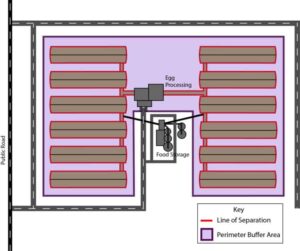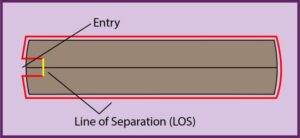Die ersten paar Jenga® Die Blöcke sind immer am einfachsten. Ein paar Fingertipps, um zu sehen, welche Blöcke locker sind, und schon ist es ziemlich sicher, einen Block zu entfernen. Erst wenn mehr Blöcke entfernt werden und der Turm anfängt, schwach und schief zu werden, wird das Spiel spannend. Bald ist der Turm nur noch so stark wie sein schwächster Punkt in der Struktur. Wie viele Blöcke können entfernt werden, bevor der Turm umkippt? Wir scherzen, dass es bei Jenga nicht einen Gewinner, sondern nur einen Verlierer gibt. Eine Person zieht den Block, der den Turm zum Einsturz bringt.
Wie wäre es, wenn wir an jeden der 14 Biosicherheitsgrundsätze des Nationaler Plan zur Verbesserung der Geflügelwirtschaft wie die Blöcke bei einem Jenga-Spiel? Genauso wie die ersten paar Jenga-Blöcke leicht zu entfernen sind, ist es leicht, einige Biosicherheitsmaßnahmen zu entfernen oder zu übersehen. Ehe wir uns versehen, haben wir so viele "Blöcke" entfernt, dass unser Programm schwach ist und ein einziger Fehltritt es zum Einsturz bringen kann. Unser Biosicherheitsprogramm ist nur so stark wie das schwächste Glied im Fundament.
Die Einbeziehung von Jenga war eine unterhaltsame Art, die Bedeutung von Biosicherheit und Hygiene zu vermitteln. Wir wissen, dass Biosicherheit eine Reihe von Verfahren ist, die die Einschleppung und Ausbreitung von Krankheiten verhindern sollen, aber die Umsetzung von der Theorie in die Praxis ist immer eine Herausforderung Wie kommen wir von einer Definition zu einer Denkweise? Wie können wir sicherstellen, dass wir keinen einzigen Schritt in unserem Biosicherheitsprogramm übersehen? Wie schaffen wir es, dass unsere Biosicherheitsmaßnahmen nicht mehr nur auf einem Stück Papier im Firmenbüro stehen, sondern dass jeder Mitarbeiter des Betriebs sich darum kümmert? Es beginnt damit, die Bedeutung der Biosicherheit zu verstehen.
Warum ist die Biosicherheit so wichtig?
- Biosicherheit wirkt sich auf die Rentabilität aus.
Gesunde Vögel = ein gesundes Ergebnis. Wussten Sie, dass die Gesamtauswirkungen der HPAI-Ausbruch 2014-2015 im Mittleren Westen (einschließlich Handel) unsere Industrie mehr als $3 Milliarden kostet? - Schutz vor lebensmittelbedingten Krankheitserregern.
Wir bemühen uns, sichere Lebensmittel für den menschlichen Verzehr zu produzieren. Wir verbessern ständig die Art und Weise, wie wir Lebensmittel verarbeiten, und unsere Hygienepraktiken in der Verarbeitungsanlage. Rückrufe betreffen die gesamte Lieferkette, und gute Biosicherheitspraktiken tragen dazu bei, das Risiko der Übertragung von Krankheitserregern vom Bauernhof in den Verarbeitungsbetrieb zu minimieren. - Die Biosicherheit ist das Herzstück eines jeden Tierschutzprogramms.
Eine der fünf Freiheiten des Tierschutzes ist "Freiheit von Schmerzen, Verletzungen oder Krankheiten". Als Tierpfleger wollen wir das Beste für die Tiere in unserer Obhut und streben danach, sie so effizient und human wie möglich aufzuziehen.
Biosicherheits-Linien
Heute wollen wir uns auf die Grundsätze drei und vier aus Die 14 Biosicherheitsgrundsätze des NPIP - Biosicherheitslinien: Pufferzone und Trennlinien.

Perimeter-Pufferbereich (PBA) - Ihre erste Verteidigungslinie! Die PBA kann viele Formen annehmen. Sie kann so ausgeklügelt sein wie ein Zaun um ein Grundstück oder so einfach wie gemähtes Gras, das das Gebiet von den Feldern um Ihr Grundstück abgrenzt. In jedem Fall muss dieser Bereich in Ihrem Plan beschrieben oder dargestellt werden. Es sollten eindeutige Verfahren (z. B. Reifenwaschanlagen usw.) festgelegt werden, die Hausmeister, Besucher und Geräte beim Betreten und Verlassen der PBA einhalten müssen.
Trennungslinie (LOS) - Ihre letzte Verteidigungslinie! Die LOS ist die funktionale Linie, die Ihre Vögel vor der Ansteckung mit Krankheiten schützt. Ihre Biosicherheitsmaßnahmen sollten in diesem Bereich am strengsten sein und eine Form der Kontrolle der Einflugschneisen beinhalten. Auf dem Markt gibt es viele Produkte zur Kontrolle der Einflugschneise. Jedes Produkt, das im Rahmen eines Biosicherheitsprogramms verwendet wird, sollte bei der EPA registriert sein und die Krankheitserreger, auf die Sie abzielen, auf dem Etikett aufführen.
Eingangskontrolle

Sterilex hat es sich zur Aufgabe gemacht, Ihnen die Instrumente an die Hand zu geben, die Sie benötigen, um Ihr Biosicherheitsprogramm zu verbessern und Ihre Herde zu schützen. Wir glauben, dass Schutz ist Prävention. So wie jeder Jenga-Block für einen Biosicherheitsgrundsatz steht, wollen wir Ihnen Werkzeuge an die Hand geben, die Ihr Fundament stärken.
FortiGuard, unser Fußwannenpulver, ist ein von der EPA zugelassenes Desinfektions- und Reinigungsmittel. Es wurde strengen Tests durch Dritte unterzogen, um zu beweisen, dass es Organismen, einschließlich der Vogelgrippe, abtötet, Salmonella enterica, Staphylococcus aureus, Pseudomonas aeruginosa, E. coliund andere Krankheitserreger*. Und da es bei der EPA registriert ist, wurde es überprüft. Mit dem Sterilex-Teststreifen-Kit können Sie schnell testen und überprüfen, ob die Wirkstoffe noch stabil sind - Ihr nützlichstes Werkzeug bei einer Prüfung.
*Die vollständigen Angaben auf dem Etikett und die Verwendungshinweise sind dem Produktetikett zu entnehmen.
Zusammenfassung
Lassen Sie nicht zu, dass die Eingangskontrolle das schwächste Glied in Ihrem Biosicherheitsprogramm ist. Es gibt viele Produkte auf dem Markt, aber haben Sie deren Etiketten überprüft? Sind die Produkte, die Sie verwenden, speziell dafür ausgelegt, Ihre Herde vor Krankheiten zu schützen, oder vermitteln sie Ihnen ein falsches Gefühl der Sicherheit, das dazu führen könnte, dass Ihr gesamtes Programm zusammenbricht, wenn eine Krankheit Ihre Herde bedroht?
Wenn Sie Fragen haben oder weitere Informationen darüber wünschen, wie FortiGuard zum Schutz Ihrer Herde beitragen kann, besuchen Sie unsere Produkt Seite.